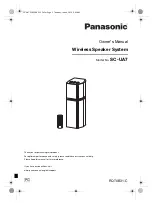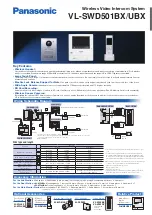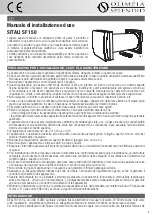
3
For more information on Direct Coil products call (613) 544 2200 | 5055 Taylor Kidd Blvd, Millhaven, Ontario K0H 1G0
www.directcoil.com
Installation
1.
Remove the coil from the shipping container and
avoid damaging the fins. Any bends can be
straightened using the appropriate equipment
2.
It is recommended to clean the coil using an industrial
coil cleaner before installation
3.
Pressure test the system before adding the
water/glycol solution. Test pressure should not
exceed low pressure
4.
Fill the system until the coil is half full, then purge air
from all vents. Operate system for a minute then
purge all vents again and add fluid as required.
Repeat the purging of all vents after the first hour of
operation and again after several hours of operation
5.
Connect the water supply to the bottom connection on
the header assembly. Connect the water return to the
top connection on the header assembly. Connecting
the supply and/or return in any other configuration will
impact performance
6.
Ensure that the coil is mounted in a level position to
insure drainability and that clearance is given
between the coil face and any surrounding structures.
All pipe brazing must be done using high quality materials
and must be tested for leaks. Pipe sizes for the system
must be selected based on the head (pressure) available
from the circulation pump. For chilled water coils, the
condensate drainpipe should be sized adequately to
ensure the condensate drains properly
(see Piping
Schematics)
Recommendations
1.
All piping should be in accordance with accepted
industry standards.
2.
Water coils are not normally recommended for use
with entering air temperatures below 40°F (4°C).
Glycol solutions or brines are the recommended safe
operating media for water coils with low temperature
entering air conditions
Lifting Instructions
When lifting a coil, one should ensure that proper
precautions are taken, including:
-
Wearing safety equipment, such as hard-toe
shoes
-
Safety gloves
One should also lift while maintaining proper posture, as
water coils are heavy and improper procedure could
cause harm.
NEVER LIFT A COIL BY THE HEADER, CIRCUITS,
OR CONNECTIONS.
1.
Any coil that is 45 pounds or heavier will have
two removeable lifting brackets. Use only these
when lifting the coil
2.
When lifting a coil, lifting should be done by the
legs and the coil kept close to the center of
gravity
3.
If the coil is too heavy, find help and perform an
assisted lift
Piping Schematics
This section is a guide for the correct installation of the
cooled water piping system; however, Direct Coil is not
responsible for the installation of the piping.
1.
After both glycol lines are connected, the entire
system must be leak tested. Care should be given to
those parts which will be inaccessible in future dates.
2.
DO NOT USE GALVANIZED PIPNG IF GLYCOL IS
TO BE USED IN A CHILLED WATER SYSTEM:
-
Chemical reactions between the glycol and the
galvanized piping can be detrimental to the
cooling system, the glycol and unit
3.
The header, pipes, and brazed joints should not be
used to support any loads or weight
4.
Piping material may be copper, plastic, carbon or
stainless steel depending on the requirements of
each installation
5.
Ensure that all field piping is self-supporting and can
accommodate thermal expansion and contraction (of
the coil)
All piping must be installed only by a licensed
plumbing contractor, and in compliance with local
codes. It is the responsibility of the engineer and/or
the piping contractor to ensure that the piping is
correctly sized in relation to the installation.

























